

Binocular Reviews Home > Buyer & User Guides > What to look for in Binoculars

So you have decided to purchase a pair of binoculars, but where do you start?
Full size, mid size or compacts, roof prism or porro prism, cheap or expensive, coated or multi-coated... the list goes on and on!
Too Much Choice?
Not only is there are huge amount of options and choices available, but you may also have questions like why there are such massive differences in price between the cheapest and most expensive instruments?
Then there are all the optical terms and numbers to get your head around, so for someone new to the world of optics I totally understand how it can all seem a little daunting and at first seem difficult to know what to look for when buying binoculars.
But don't worry!
In this binoculars buyers guide, I will take you through the binocular basics right up to advanced features and insiders tips in an easy to understand language so that you can be confident that you know what to look for and that you end up buying the right pair of optics for your particular needs and interests and at price that matches your budget.
As with most things, I think the best place to start is right at the beginning, so in the next few paragraphs, I will take you through the real binocular basics.
If you are not a complete beginner, you can of course skip to any point after this by using the table of contents on the right to view the more advanced tips and expert advice.
8x42, 10x42, 10x32, 10x26, 10x50, 12x56 - What exactly do these numbers mean, what do they tell us about a binocular and which ones should you get for your desired use?
At it's most basic level, the main purpose of any binocular is to magnify the view and thus bring distant objects more clearly into vision by making them look closer or larger.
Thus it stands to reason the most important thing to know and get right is by how much a particular pair magnifies the view and indeed how much magnification you need for what you intend to use them for.
Luckily for us, manufacturers make the first part of this really easy for us as almost every bino sold has the magnification included in it's name:
So when you see "8x42", the first number followed by an "x" is the magnification. So in this example, the binoculars have an 8x magnification and thus it will make whatever you look at through them seem eight times (8x) closer (or larger) than what they would with the naked eye.
Binoculars with 10x42, 10x32 or even a 10x26 in their name will all magnify the image ten times (10x)
Exactly how much magnification you need, or the ideal amount for your intended use is a little more tricky to get right as it depends on a whole bunch of other factors, some of which we will get to later on in this guide. If you wish, you can also take a look at this guide to How a Binoculars Magnification affects Stability, Field of View & Image Brightness.
But for now what is important to know is that that bigger is not always better and a good rule of thumb is to say that for most general uses, 8x or 10x is probably going to be about right.
The number that comes directly after the magnification when looking at the name on a binocular indicates the size (diameter) in millimeters of the main objective lenses (those are the bigger ones on the end of the binoculars).
So using the examples above, an 8x42 binocular has 42mm diameter objective lenses. A 10x42 will also have the same size (42mm) lenses, but with a higher magnification.
Whilst the 10x32 has 32mm objective lenses and those on the 10x26 are 26mm across.
The size of these lenses is important in many ways:
Firstly it plays a major factor in determining just how physically big the overall instrument will be: the larger the lens, the bigger and heavier the binocular.
So why would you want larger lenses?
Well a good way to think of it is like looking through a window. A larger window lets in more light than a small one.
This is the same with lenses: The increased surface area of larger objective lenses means they are able to capture more light and thus play a critical role in determining the brightness or more accurately the low light performance of the binocular.
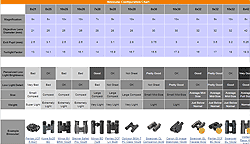 Binocular Configurations & Which to Choose
Binocular Configurations & Which to Choose10x42, 8x42, 8x32, 10x26... Which set-up is right for you and your particular requirements?
In this document and with the help of my "Binocular Configuration Chart", I go through each of the most common binocular configuration combinations, highlighting their particular strengths and weaknesses to help you decide which is the most suitable for your needs:
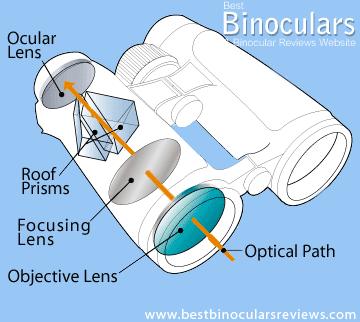
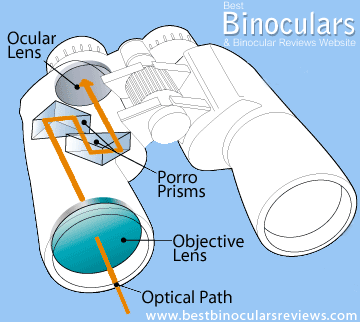
The basic design of a binocular falls into two broad categories that are largely the result of what type of prism that they use inside of them to correct the image and turn it the right side up after it has passed through the objective lens.
Most people will recognise the traditional shape of a binocular where the eye-pieces are closer together than the objective lenses. As I say, this shape was down to the use of the porro prism inside (image above left).
Roof-prisms binoculars (image above right) and their straight through body shape came later on and were developed because this new prism design enabled a smaller, more compact binocular to be produced.
Over the yeas and as the technology and materials used has progressed, the gap in terms of size and weight between the two designs have become less and less however depending on your budget, each design still has particular advantages over the other.
In general Porro prisms are lass difficult and cheaper to make, so at the cheap end of the market, you often get a better optical performance with a porro prism binocular.
Whilst they cost more, roof-prism binoculars are generally manufactured to closer optical and mechanical tolerances, giving a you a better performing product at the higher end of the market. The porro prism design is still more compact, especially on binoculars with larger lenses (around 40mm and above).
But apart from that a lot will come down to you personal preferences as to which style you like the look of and which feels better and more comfortable for you to hold
Further Reading: Cheap Binoculars - Is a Roof or Porro Prism Best?

And How to Avoid Them
The most common mistakes I see people new to binoculars (and other optics) make when choosing binoculars to buy and how not to make them yourself.
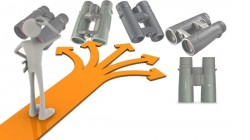
Once you have taken time to read the reviews and narrowed your shortlist down to a few or perhaps even just two binoculars. How do you go about choosing between them? Read my guide on how to choose between a few binoculars and make sure that you get the one that is best suited to your specific needs.
So now that we have the basics, next we need to understand more about which features and components are important and take note of the signs of what to look for in binoculars that indicate it's quality.
Not only are the external features on a binocular important in terms of usability and durability, but they can tell you a lot about what the level of the optics and the potential view quality is likely to be:
In general if the manufacturer takes the time and money paying attention to small details and using superior materials to make the outer housing on their instrument stand out, then it stands to reason that they have most likely done the same with the optics and their coatings on the inside.
So even if you don't know too much about optics, you can get a good feeling for what sort of level it is most likely to be at, just by paying attention to the exterior:
Even though you think you may not need it, a binocular that has been fully sealed with O-rings and thus waterproof is not only protected from the rain and wet conditions, but will also be impervious to dust as well.
Pro Tip: Take careful note of the exact wording used. A "weather-proof", "weather protected" or "water-resistant" instrument is most probably not fully sealed. You are looking for a product that is described as both waterproof and fog proof using either nitrogen or argon gas. This is a sure indication of a much better quality instrument than ones that are not.
More Info: Guide to Fogproof and Waterproof Binoculars
Underneath the rubber coating that you find on most modern binoculars, is the chassis. This shell is most commonly made from either Polycarbonate plastic, Aluminum or at the top end Magnesium.
Most cheap binoculars will made from Polycarbonate, which other than costing less has other advantages which include being much less susceptible to expansion and contraction caused by temperature than the metal alloys, something that over time can affect the columniation of the optics, so makes them better suited to use in extreme conditions. It is also very lightweight.
However on the negative, it is not as strong and just lacks that certain feeling of quality and substance that you get with metal a metal body instrument.
Designed to keep our eyes the correct distance from the ocular lenses so that you see the full image, eye-cups are an important component of any binocular.
Whilst not always the case, cheaper, lower quality binoculars quite often have simple rubber eye-cups that fold up down to adjust your eye-relief. Whilst most better quality binoculars will have twist-up and down eye-cups.
These simply work better and the potentially give you far more adjustability and options when it comes to setting the correct amount of eye-relief for your needs.
However just know that there are some really great quality binos that have rubber cups, so don't assume that all rubber cup bins are bad and this indicator should be taken in conjunction with the others discussed to get a fuller more accurate understanding.
Look out for lockable diopter adjustment rings or ones that are integrated onto the central focus wheel. You will sometimes see these on higher end binoculars and is sometimes small details like this that separate the excellent from the very good.
For more details on what a diopter does and the different types take a look at my guide to How To Calibrate and Focus Binoculars
Apart from the level of craftsmanship used in manufacture which we can't tell by reading the features on the box, it is the quality of optical glass and the coatings used that are the most important aspects and what you really need to look for when buying binoculars.
Added to protect the lenses, help reduce unwanted reflections and glare as well as improving light transmission and contrast, almost all modern binoculars have at least some level of coatings applied to some or all of the lens surfaces in the optical pathway.
But beware, here is where you get a lot of marketing hype and confusion and it is really important to pay close attention to the wording used:
 First off, there are many manufacturers of really cheap binoculars that add a simple (and cheap) coating onto the exterior lenses to give them a cool-looking green, orange, yellow or red tint. They often describe the binocular as a day/night binocular, inferring that these coatings somehow improve performance and even make them work at night, but in reality, these do nothing to improve the view. Indeed they can sometimes actually do more harm than good!
First off, there are many manufacturers of really cheap binoculars that add a simple (and cheap) coating onto the exterior lenses to give them a cool-looking green, orange, yellow or red tint. They often describe the binocular as a day/night binocular, inferring that these coatings somehow improve performance and even make them work at night, but in reality, these do nothing to improve the view. Indeed they can sometimes actually do more harm than good!
However there are also some really great exterior coatings that also have a tint to them (often greenish in color) that are designed to protect the glass from scratching or even help keep them stay clean and repel water. There are also others on some hunting binoculars in particular that can help emphasise a particular colour and thus designed to help you spot animals better by making them stand out from the background.
The binoculars that use these are usually in the mid range to higher categories and most certainly not cheap. Also they are likely to explain the use of these in detail in the description of their product, so you can tell quite quickly that they are genuine.
 Anti-Reflection Coatings
Anti-Reflection Coatings
Here again, pay particular attention to the words used: cheap binoculars will highlight the fact that the lenses are "Coated", "Multi-Coated" or even "Fully Coated" with anti-reflection coatings.
It sounds great, but unless your budget is very low, what you are really looking to read is that the binocular you are buying is "Fully Multi-Coated" which tells us that all the air to glass surfaces on the bin have multiple layers of anti-reflection coatings on them and thus will perform far better than those with less coatings on fewer surfaces.
For more: Guide to Anti-Reflection Lens Coatings on Binoculars
We have already discussed how using either a roof or porro prism largely dictates the overall shape of the binocular in the designs section above, but the type of prism and the specific glass that is used to make it and any coatings play a large part in determining the quality of the image produced.
BaK-4, BK-7 and SK-15 Prisms
Modern binoculars are mostly made from one of three types of glass. Which one they have can greatly affect the image quality and thus these days the choice is primarily down to price. However having said that, each has it's own unique properties and as such there are some cases where the use of one is preferable over the other, even though it may be cheaper to produce.
But in general BAK-4, or Barium Crown glass, is deemed to be the best glass for use in most types of binoculars and is what you want to see highlighted in the list of features. BaK-4 glass has a high refractive index and lower critical angle than the others, that in binoculars translates to improved light transmission with less lost because of internal reflection.
BK-7 glass is mostly found on low cost and heap binoculars and whilst it is considered to be inferior to BAK4, but is still optical grade glass with good light-transmission properties. SK-15 is far less common, but actually strikes a good balance balance between the other two.

Types of Prisms
Within the cheaper range of binoculars, it is often better (but not always) to go for a porro prism as this design does not require a number of coatings that are needed on the roof prism to get the same image quality and brightness. For more take a look at this article: Cheap Binoculars - Is a Roof or Porro Prism Best?
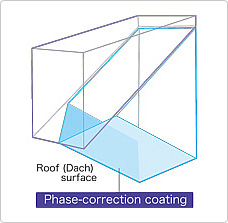 Prism Coatings
Prism Coatings
If you do decide to opt for a roof prism binocular, to get the best performance they require a couple of special coatings and so, here is what you need to look for in the binoculars description:
Phase Correction Coatings: Light that travels through a roof prism splits into two slightly out-of-phase beams, which if left uncorrected delivers an image that has a lower resolution and contrast. So what to look for when buying binoculars are descriptions that say they have prisms have Phase Correction Coatings or sometimes described as Phase corrected Prisms.
Pro Tip: Whilst these phase correction coatings do make a observable difference, they are quite expensive to apply, so many lower quality instruments will come without to save on production costs. However unless you are on the tightest of budgets, I would recommend that you try and make sure the bins you get have these. For more, take a look at my guide to Phase Correction in Binoculars.
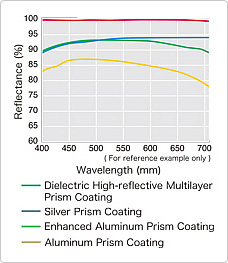 Highly Reflective Prism Coatings: The other downside to the roof prism is that unlike the porro prism, not all the light that enters it comes out the other side (the do not naturally have total internal reflection).
Highly Reflective Prism Coatings: The other downside to the roof prism is that unlike the porro prism, not all the light that enters it comes out the other side (the do not naturally have total internal reflection).
To limit internal light loss and thus help deliver a brighter and better quality image, better quality optics will have highly reflective mirror coatings added to the problematic surface.
Very high quality and thus usually quite expensive binoculars will have dielectric coated prisms which enable almost 100% of the light throughout the entire spectrum to go through the prism. These coatings are expensive and a a sure sign that you are looking at a very good to excellent quality product. If a binocular has these, they will almost certainly highlight it in the description and so will be easy to spot.
More common amongst mid to high end instruments are the cheaper costing sliver mirror coated prisms that have a reflectivity of between 95% to 98% which is still very good and perfectly acceptable if you are have a mid range budget.
Cheaper still are aluminum mirror coatings used on lower end products.
Pro Tip: If a manufacturer is using aluminum mirror coatings, they are unlikely to highlight it and so simply won't mention it in the description. So if you are shopping in the low cost and cheap price ranges, this is most likely what you will get. However there will be some at this price range that have silver coated prisms and which will thus most probably highlight it, so this is certainly what to look for in binoculars at this level.
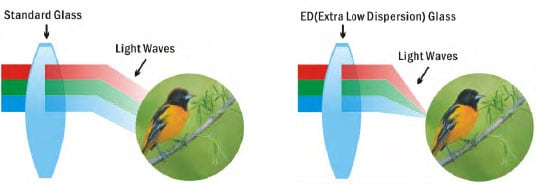
Whilst all modern bins will use low dispersion glass elements in their lenses, it has become more and more popular to add elements that have extra-low dispersion properties, which if skillfully used has the potential to further correct chromatic and spherical aberrations.
When it first came out, you only found ED glass on very high end binoculars, but now I see it used on many mid range and even what I would describe as lower cost instruments.
Pro Tip: However just using ED glass does not necessarily mean that you get the benefits, it needs to be skillfully incorporated into the entire optical system. The problem here is the level of manufacture of the compound lenses and indeed the rest of the optics is not the same as what you get at the very high end of the market and so just because a binocular has ED glass does not guarantee it will be better than those around it that don't.
For more take some time to read my guide to Extra Low Dispersion Glass (ED Glass) used in binoculars.
Also worth checking out:
Hawke Frontier ED X versus Vortex Diamond back HD binoculars. Bresser Pirsch ED or GPO Passion HD binoculars?
You see the HD term in binocular names more and more these days. But exactly does it mean and how are they different to ED binoculars?
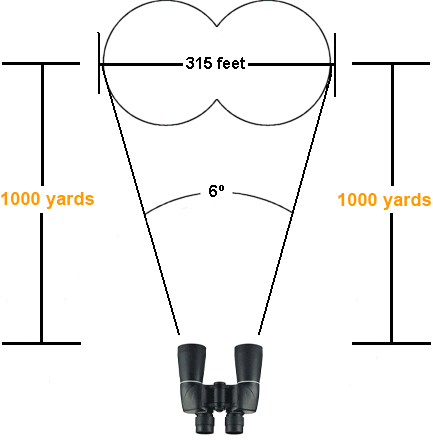 Specifications
SpecificationsMost manufacturers will supply a table listing a bunch of specifications pertaining to the binocular in question. Many will highlight certain ones and make it sound like it they are superior to their competitors when in fact they are not. Or they will gloss over the ones where they are weakest Then there are many that are really not that important at all, but they make it sound like they are!
So here is my take on the most important specifications and what to look for when buying binoculars:
The "field of view" (FOV) or "angle of view" (AOV) are different ways of describe the amount of scenery (width of image) that is visible when you look through the binocular.
The AOV is expressed in degrees, whilst the FOV is a measurement in feet or meters describing the width of the view at a certain distance away. In the example in the image on the right, the binoculars have a 6° angle of view which equals a FOV of 315ft at 1000 yards.
 In general and for most uses it is advantageous to have the widest field of view possible as you get to see more of what is going on and objects are easier to find and follow, which for wildlife observation, sports and especially bird watching is important.
In general and for most uses it is advantageous to have the widest field of view possible as you get to see more of what is going on and objects are easier to find and follow, which for wildlife observation, sports and especially bird watching is important.
But you have to look at it in relation to the magnification of binocular as generally speaking, the higher the magnification, the narrower the field of view which is demonstrated in the image on the right and which is why, unless you are observing birds over long distances, most of the best birding binoculars tend to be lower powered (8x or 7x).
Pro Tip: Once you have decided on your preferred magnification, then compare them, looking out for those within that class that have the widest views.
 Wide Field of View Binoculars
Wide Field of View BinocularsWhilst a wide field of view is almost always desirable, having a really wide field of view is can be important to some users in certain situations. In particular, many birders look for binocular with a wide viewing angle.
In the following guides I explain the field of view in-depth, why and when it is an important aspect to look out for when buying binoculars and then list some of the best binoculars with very wide views:
>> Wide Angle Binoculars
>> Wide Angle 10x42 Binoculars
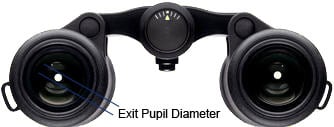 In simple terms, the exit pupil is a measurement of the diameter of the shaft of light that comes out of the eyepiece and onto your eye.
In simple terms, the exit pupil is a measurement of the diameter of the shaft of light that comes out of the eyepiece and onto your eye.
Related to both the magnification and the size of the objective lenses, the exit pupil is an important indicator of how well the binocular is likely perform in low light conditions because a larger exit pupil means more light can be taken in by your eyes.
For a full explanation, how much you need and how to calculate the exit pupil size if it is not included on the specifications list, take a look at my Complete Guide to the Exit Pupil.
Depending on your specific circumstances, the follow two specifications may be of great importance and well worth making sure that you understand and factor them into your search:
As they are mostly designed for looking at distant objects, it may seem strange that the minimum focus distance is something to look for in binoculars and for most people this is true.
However if you enjoy viewing insects or flowers and even birds on a nearby feeing table or bush outside a window for example, then a binocular with a good close focus distance will be important. For most normal binoculars anything at or under 6 feet is considered very good.
However you can also get some specifically designed for close focus. For more, take a look at my guide to Insect & Butterfly Binoculars
 If you wear eyeglasses and want to continue to use them whilst looking through your binoculars, you will need a pair of binos with an eyepiece that gives you plenty of room for adjustment to ensure that you still get to view the full image.
If you wear eyeglasses and want to continue to use them whilst looking through your binoculars, you will need a pair of binos with an eyepiece that gives you plenty of room for adjustment to ensure that you still get to view the full image.
In other words you need a binocular that comes with a good amount of eye-relief.
For more on exactly what it is, what to look out for and some recommendations on what to get, take some time to read my complete guides to:

Just about every binocular enables you to change the distance between the eye-cups to match the distance between your eyes.
This is usually achieved by opening and closing the hinge on the binocular and most are designed to cater for the vast majority of people.
However if you have particularly close or far set eyes or if you are looking to specifically get a binocular for a child then the range that they can cover is important
The next and final step in what to look for when buying binoculars is to decide on a budget.
Now I can't tell you exactly what amount you need to spend (my suggestion is always the most that you can afford to loose!) But what we can do is get a realistic expectation of what you can expect to get at your chosen budget.
In this way you will know if the binocular you are looking at is good or bad value for money:
 In these documents I explore and point out the main differences between cheap, mid range and expensive binoculars to discover just where the extra money goes when you buy a top of the range model.
In these documents I explore and point out the main differences between cheap, mid range and expensive binoculars to discover just where the extra money goes when you buy a top of the range model.
I also take a look at what makes a binocular good or even great value for money and give some of my recommendations to some of the very best that I have reviewed:

What exactly makes good value for money and can you have a really expensive binocular that is better value than a cheap one?
I explore these and other questions as well as list why I believe are the best value optics is a range of different price categories:
>> Best Value For Money Binoculars
>> Best Value Birding Binoculars